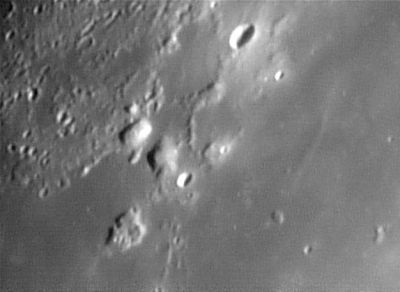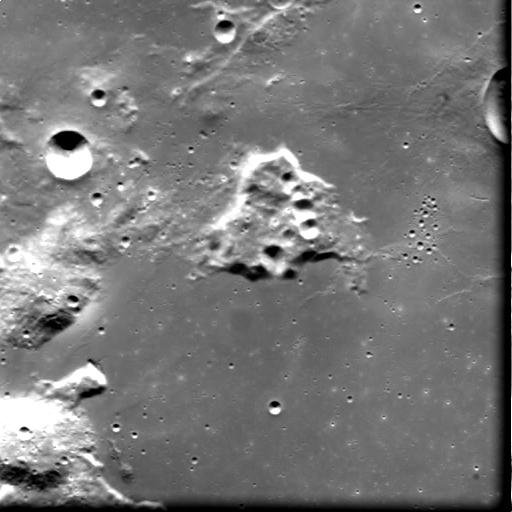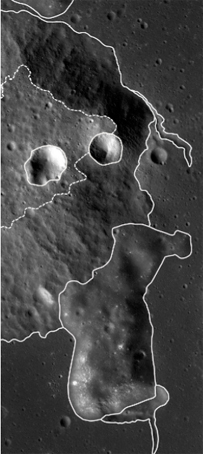Difference between revisions of "Mons Gruithuisen Gamma"
(Created page with "<div id="content_view" class="wiki" style="display: block"> =Mons Gruithuisen Gamma= ''(current [/IAU IAU] name; former IAU name: '''[/Gruithuisen Gruithuisen] Gamma''')''<b...") |
|||
| Line 51: | Line 51: | ||
==LPOD Articles== | ==LPOD Articles== | ||
| − | * [http:// | + | * [http://www2.lpod.org/wiki/March_23,_2006 Low Sun Paradise] |
| − | * [http:// | + | * [http://www2.lpod.org/wiki/March_30,_2004 Silicic Domes?] |
* [http://lpod.wikispaces.com/December%2013%2C%202009 Geo Textbook] | * [http://lpod.wikispaces.com/December%2013%2C%202009 Geo Textbook] | ||
<br /> | <br /> | ||
Revision as of 19:25, 11 April 2018
Contents
Mons Gruithuisen Gamma
(current [/IAU IAU] name; former IAU name: [/Gruithuisen Gruithuisen] Gamma)
|
Lat: 36.59°N, Long: 40.72°W, Diam: 19.65 km, Height: km, [/R%C3%BCkl%209 Rükl: 9] | ||
Middle: SMART-1 This space-based view, with north roughly to the left, appears to have been taken from over [/Gruithuisen Gruithuisen] Zeta (the scab-like hill). Mons Gruithuisen Gamma is partially visible in the lower left corner with [/Mons%20Gruithuisen%20Delta Mons Gruithuisen Delta] and [/Gruithuisen Gruithuisen] B above it. The northern rim of 15-km diameter [/Gruithuisen Gruithuisen] is visible near the top of the right margin. Right: LROC NAC M104783697 image of the eastern portion of Gruithuisen Gamma (see Bibliography paper below).
Table of Contents
Images
LPOD Photo Gallery Lunar Orbiter Images Apollo Images
- Lunar Orbiter 5's Frame 183 shows both Gruithuisen Gamma and Delta, and also the chain of teardrop-shaped craterlets near the [/concentric%20crater concentric crater] Gruithuisen K (near the photograph's upper left corner).
- Somewhere very near the upper left corner of Lunar Orbiter 4's photograph LOIV-145-h1, immediately west of Mons Gruithuisen Gamma, should be the location of the 33th item in C.A.Wood's list of Concentric Craters (1978).
- Research Lunar Orbiter photographs: Danny Caes
Maps
([/LAC%20zone LAC zone] 23C2) LAC map Geologic map
Description
Elger
([/IAU%20Directions IAU Directions]) GRUITHUISEN DELTA AND GAMMA.--On the N. of this bright crater, in N. lat. 36 deg., W. long. 40 deg., rises a fine mountain, [/Mons%20Gruithuisen%20Delta delta], nearly 6000 feet in height, and on the N.W. of it the larger mass gamma, almost as lofty.
Wikipedia
Additional Information
- IAU page: Mons Gruithuisen Gamma
- Age estimate of 3.85 to 3.7 billion years based on crater counts (Wagner et al, 2002, Stratigraphic sequence and ages of volcanic units in the Gruithuisen region of the Moon. J. Geophys. Res. 107, E11, 5104 ).
- According to C.A.Wood's list of Concentric Craters, there should be one immediately west of Mons Gruithuisen Gamma.
- Unexplored Areas of the Moon: Nonmare Domes A White Paper submitted to the Planetary Science Decadal Survey 2013-2022 - astrokat astrokat Aug 8, 2010. Primary Author: Sarah E. Braden, School of Earth and Space Exploration, Arizona State University
- Diviner IR data identifies this as one of the most silica-rich volcanic regions of the Moon. (Glotch et al, , 2010).
Nomenclature
- Named after the nearby crater. ([/Gruithuisen Gruithuisen])
- In the original [/IAU%20Nomenclature IAU Nomenclature] of [/Named%20Lunar%20Formations Named Lunar Formations] this feature was known as Gruithuisen Gamma. Although all such Greek-lettered names were discontinued in [/IAU%20Transactions%20XVB IAU Transactions XVB] (1973), this name was restored (with the addition of the Latinized "Mons" prefix) in [/IAU%20Transactions%20XVIB IAU Transactions XVIB] (1976). - JimMosher JimMosher
- In his informal 1953 tour of [/Mare%20Imbrium Mare Imbrium], [/Copeland%2C%201953 Leland Copeland] referred to the Gruithuisen mountains as the Three Rocks. Research: - DannyCaes DannyCaes Feb 23, 2008
- Mons Gruithuisen Gamma; the dome-like mountain, is nicknamed The Topsy-Turvy Bathtub by Danny Caes and others. Note that this nickname is not new! It seems to be one of the early telescopic observers of the moon. And indeed: through telescope it looks very much like a bathtub! (Topsy-Turvy on the lunar surface). - DannyCaes DannyCaes Feb 23, 2008
LROC Articles
LPOD Articles
Lunar 100
[/Lunar%20100 L49]: Volcanic domes formed with viscous lavas.
Bibliography
- Braden, S.E. et al (2010). Morphology of Gruithuisen and Hortensius Domes: Mare vs NonMare Volcanism from the 41st Lunar and Planetary Science Conference (2010).
- Glotch, T.D. and others (2010) Highly Silicic Compositions on the Moon. Science 329 no. 5998 pp. 1510-1513.
- Wood, C.A. 3/2007. Odd Lunar Domes. S&T 113(3):55-56
- Hill, Harold. 1991. [/Hill%2C%201991 A Portfolio of Lunar Drawings], pages 90, 91.
[/Alphabetical%20Index Named Features] -- Prev: [/Mons%20Gruithuisen%20Delta Mons Gruithuisen Delta] -- Next: [/Gruithuisen Gruithuisen]
This page has been edited 1 times. The last modification was made by - tychocrater tychocrater on Jun 13, 2009 3:24 pm - afx3u3


